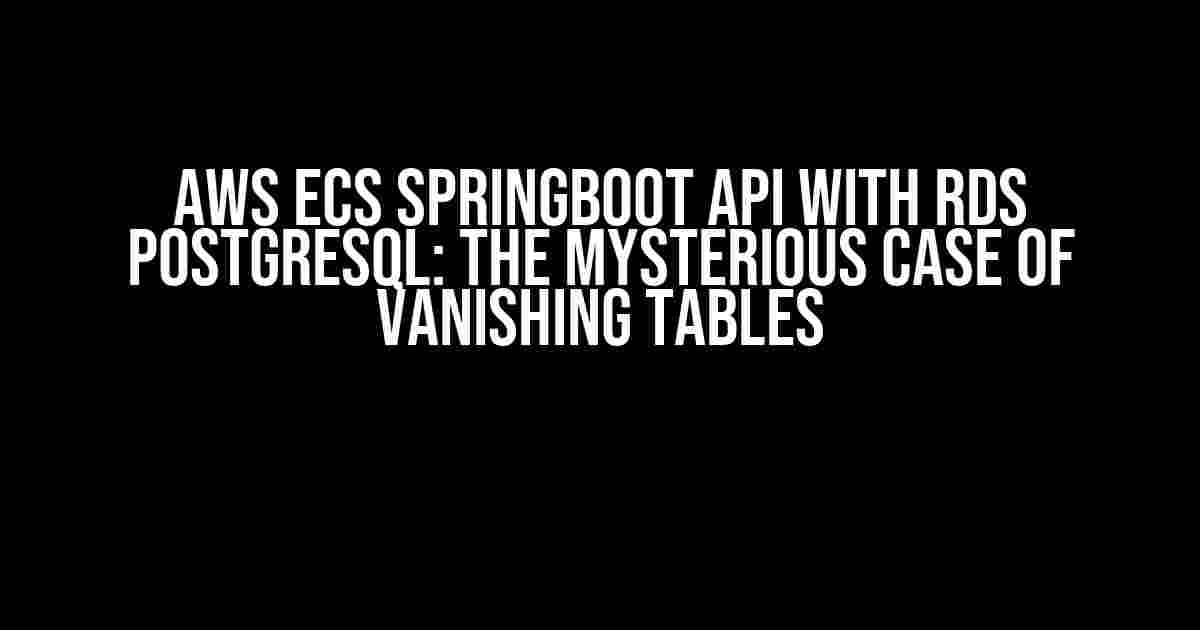If you’re reading this, chances are you’ve stumbled upon a perplexing issue while deploying an AWS ECS (Elastic Container Service) SpringBoot API connected to an RDS PostgreSQL database. Congratulations, you’re not alone! In this article, we’ll dive into the bewildering phenomenon where all your tables disappear 3-4 minutes after a successful startup.
The Setup
Before we begin, let’s confirm that you’ve got the following setup:
- AWS ECS cluster running a SpringBoot API container
- RDS PostgreSQL instance as the database
- _successful_ deployment and startup of the API using ECS
- initial verification that all tables exist and are accessible
The Issue
Here’s the kicker: approximately 3-4 minutes after a successful startup, you notice that all your tables have vanished into thin air! You’ve double-checked the database credentials, ensured the correct schema is being used, and even performed a few sacrifices to the database gods – but to no avail.
Why Does This Happen?
The reasons behind this enigmatic issue can be attributed to a combination of factors:
flywayor other database migration tools: These tools analyze the database schema and apply changes to ensure it’s up-to-date. However, they might not account for the temporary delay in schema creation, leading to table deletions.SpringBoot‘s database initialization: SpringBoot’s auto-configuration might interfere with the database schema, causing unintended changes or deletions.RDS PostgreSQLinstance settings: Specific settings, such as theautovacuumfeature, can lead to accidental table drops.
Solutions and Workarounds
Don’t worry, we’ve got you covered! Here are some solutions and workarounds to tackle this issue:
1. Use a fixed delay in Flyway configuration
In your application.properties or application.yml, add the following configuration:
flyway:
url: ${jdbcUrl}
user: ${jdbcUsername}
password: ${jdbcPassword}
schemas: ${jdbcSchema}
fixed-delay: 5m
This sets a 5-minute delay between Flyway’s repeated attempts to apply migrations, giving the database schema sufficient time to stabilize.
2. Disable SpringBoot’s database initialization
In your application.properties or application.yml, add the following configuration:
spring:
datasource:
initialization-mode: never
This tells SpringBoot to skip database initialization, preventing potential schema changes or deletions.
3. Configure RDS PostgreSQL instance settings
In your RDS instance settings, adjust the following parameters:
| Parameter | Value |
|---|---|
| autovacuum | false |
| autovacuum_vacuum_scale_factor | 0.1 |
| autovacuum_vacuum_threshold | 1000 |
By disabling autovacuum or adjusting its settings, you can prevent accidental table drops due to aggressive vacuuming.
4. Implement a retry mechanism for database connections
Create a custom retry mechanism using a library like Spring Retry or Apache Commons Retry. This will help re-establish connections to the database in case of initial failures.
@Retryable(value = { SQLException.class }, maxAttempts = 3, backoff = @Backoff(delay = 2000))
public void connectToDatabase() {
// Database connection code goes here
}
Conclusion
The disappearance of tables 3-4 minutes after a successful startup might have left you scratching your head, but we’ve demystified the issue and provided you with a range of solutions and workarounds. By applying these fixes, you’ll be able to deploy your AWS ECS SpringBoot API with RDS PostgreSQL without worrying about vanishing tables.
Remember, patience and persistence are key when dealing with complex cloud deployments. Take a deep breath, revisit your configuration, and re-deploy with confidence!
Additional Resources
For further reading and troubleshooting, explore the following resources:
Keep exploring, and happy deploying!
Frequently Asked Questions
Are you frustrated with your AWS ECS SpringBoot API with RDS PostgreSQL setup, where all tables disappear 3-4 minutes after a successful startup? Don’t worry, we’ve got you covered! Check out these FAQs to troubleshoot and solve the mystery.
Q1: Is it possible that my RDS instance is being shut down or restarted?
A1: Yes, it’s possible! Check your RDS instance’s status and event logs to see if it’s being shut down or restarted. This might be due to a misconfigured instance or a bug in your startup script.
Q2: Could my SpringBoot application be dropping the database tables intentionally?
A2: Yes, it’s possible! Check your application’s configuration files and code for any scripts or settings that might be dropping the tables. Look for keywords like “ddl-auto” or “hibernate.hbm2ddl.auto” in your application.properties or application.yml file.
Q3: Is there a chance that my AWS ECS task is being terminated or restarted?
A3: Absolutely! Check your ECS task’s status and event logs to see if it’s being terminated or restarted. This might be due to a misconfigured task definition, insufficient resources, or a bug in your application.
Q4: Could my database credentials or connection settings be incorrect?
A4: Yes, it’s possible! Double-check your database credentials, connection settings, anddatasource configurations in your application.properties or application.yml file. Make sure they match your RDS instance’s settings.
Q5: Are there any RDS PostgreSQL settings or flags that could be causing the tables to drop?
A5: Yes, it’s possible! Check your RDS PostgreSQL instance’s settings and flags, such as the “autovacuum” or “timeout” settings. These could be causing the tables to drop unexpectedly. Consult the official RDS PostgreSQL documentation for more information.
Hope these FAQs help you troubleshoot and solve the issue!
